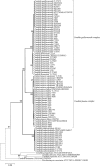Development of two molecular approaches for differentiation of clinically relevant yeast species closely related to Candida guilliermondii and Candida famata
- PMID: 24951804
- PMCID: PMC4313136
- DOI: 10.1128/JCM.01297-14
Development of two molecular approaches for differentiation of clinically relevant yeast species closely related to Candida guilliermondii and Candida famata
Abstract
The emerging pathogens Candida palmioleophila, Candida fermentati, and Debaryomyces nepalensis are often misidentified as Candida guilliermondii or Candida famata in the clinical laboratory. Due to the significant differences in antifungal susceptibilities and epidemiologies among these closely related species, a lot of studies have focused on the identification of these emerging yeast species in clinical specimens. Nevertheless, limited tools are currently available for their discrimination. Here, two new molecular approaches were established to distinguish these closely related species. The first approach differentiates these species by use of restriction fragment length polymorphism analysis of partial internal transcribed spacer 2 (ITS2) and large subunit ribosomal DNA with the enzymes BsaHI and XbaI in a double digestion. The second method involves a multiplex PCR based on the intron size differences of RPL18, a gene coding for a protein component of the large (60S) ribosomal subunit, and species-specific amplification. These two methods worked well in differentiation of these closely related yeast species and have the potential to serve as effective molecular tools suitable for laboratory diagnoses and epidemiological studies.
Copyright © 2014, American Society for Microbiology. All Rights Reserved.
Figures


Similar articles
-
Reliable differentiation of Meyerozyma guilliermondii from Meyerozyma caribbica by internal transcribed spacer restriction fingerprinting.BMC Microbiol. 2014 Feb 28;14:52. doi: 10.1186/1471-2180-14-52. BMC Microbiol. 2014. PMID: 24575831 Free PMC article.
-
Differentiation of Debaryomyces hansenii and Candida famata by rRNA gene intergenic spacer fingerprinting and reassessment of phylogenetic relationships among D. hansenii, C. famata, D. fabryi, C. flareri (=D. subglobosus) and D. prosopidis: description of D. vietnamensis sp. nov. closely related to D. nepalensis.FEMS Yeast Res. 2009 Jun;9(4):641-62. doi: 10.1111/j.1567-1364.2009.00510.x. Epub 2009 Apr 6. FEMS Yeast Res. 2009. PMID: 19385997
-
Rapid identification of Debaryomyces hansenii/Candida famata by polymerase chain reaction.Med Mycol. 1999 Apr;37(2):101-4. Med Mycol. 1999. PMID: 10361265
-
Debaryomyces hansenii (Candida famata), a rare human fungal pathogen often misidentified as Pichia guilliermondii (Candida guilliermondii).J Clin Microbiol. 2008 Oct;46(10):3237-42. doi: 10.1128/JCM.01451-08. Epub 2008 Aug 13. J Clin Microbiol. 2008. PMID: 18701668 Free PMC article.
-
Unequivocal identification of an underestimated opportunistic yeast species, Cyberlindnera fabianii, and its close relatives using a dual-function PCR and literature review of published cases.Med Mycol. 2019 Oct 1;57(7):833-840. doi: 10.1093/mmy/myy148. Med Mycol. 2019. PMID: 30649481 Free PMC article. Review.
Cited by
-
Recent trends in molecular diagnostics of yeast infections: from PCR to NGS.FEMS Microbiol Rev. 2019 Sep 1;43(5):517-547. doi: 10.1093/femsre/fuz015. FEMS Microbiol Rev. 2019. PMID: 31158289 Free PMC article. Review.
-
Azole-Resilient Biofilms and Non-wild Type C. albicans Among Candida Species Isolated from Agricultural Soils Cultivated with Azole Fungicides: an Environmental Issue?Microb Ecol. 2021 Nov;82(4):1080-1083. doi: 10.1007/s00248-021-01694-y. Epub 2021 Mar 16. Microb Ecol. 2021. PMID: 33723620
-
The first rare case of Candida palmioleophila infection reported in China and its genomic evolution in a human host environment.Front Microbiol. 2023 Jul 26;14:1165721. doi: 10.3389/fmicb.2023.1165721. eCollection 2023. Front Microbiol. 2023. PMID: 37664129 Free PMC article.
-
Candida palmioleophila candidemia and bacterial co-infection in a 3-month-old infant with biliary atresia.Front Cell Infect Microbiol. 2023 Nov 2;13:1277607. doi: 10.3389/fcimb.2023.1277607. eCollection 2023. Front Cell Infect Microbiol. 2023. PMID: 38029248 Free PMC article. Review.
References
-
- Lockhart SR, Messer SA, Gherna M, Bishop JA, Merz WG, Pfaller MA, Diekema DJ. 2009. Identification of Candida nivariensis and Candida bracarensis in a large global collection of Candida glabrata isolates: comparison to the literature. J. Clin. Microbiol. 47:1216–1217. 10.1128/JCM.02315-08. - DOI - PMC - PubMed
-
- Borman AM, Linton CJ, Oliver D, Palmer MD, Szekely A, Odds FC, Johnson EM. 2009. Pyrosequencing analysis of 20 nucleotides of internal transcribed spacer 2 discriminates Candida parapsilosis, Candida metapsilosis, and Candida orthopsilosis. J. Clin. Microbiol. 47:2307–2310. 10.1128/JCM.00240-09. - DOI - PMC - PubMed
Publication types
MeSH terms
Substances
LinkOut - more resources
Full Text Sources
Other Literature Sources
Medical
Molecular Biology Databases
Miscellaneous

